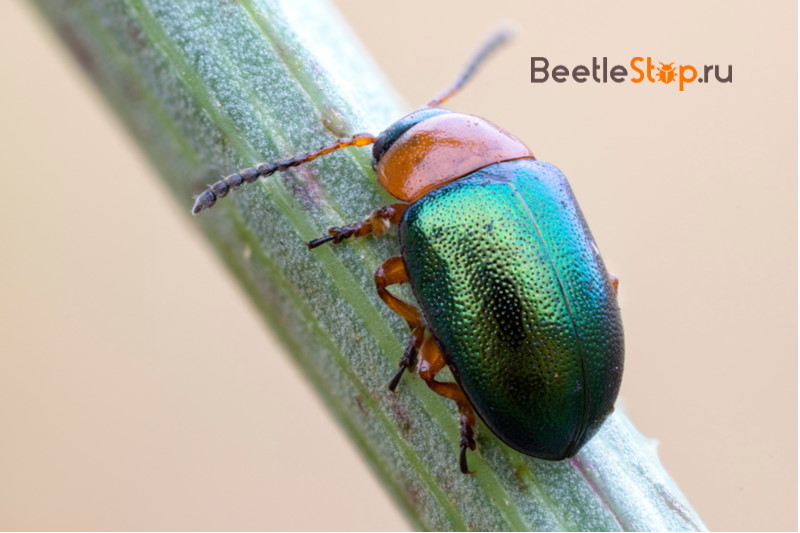Buckwheat leaf beetle - pest or helper?
A huge family of leaf beetles united 35 thousand species of phytophages. Insects are common everywhere except Antarctica and the Arctic. Small and medium beetles are brightly colored. Adult individuals and larvae in many cases harm cultivated plants, but some are used as biological agents that destroy weeds. Buckwheat leaf beetle is one of the species often found in cereal fields. Beetles feed on weeds from the buckwheat family: fallopian, highlander.

Morphological description of the species
Buckwheat leaf beetle (Gastrophysa polygoni) is a representative of the winged wing order, the leaf beetle family, and the genus chrysomeline. The size of adults is 4-5 mm. Beetles have a bright color with a metallic sheen. The body and elytra are blue-green. Pronotum, first segments of antennae and limbs red. The head is small, pulled into the prothorax. The eyes are convex, separated by a notch. Antennae 11-segmented, last segment enlarged and pointed. The base of the antennas is red, the rest is brown. The segments have setae.
Interesting fact. The genus Chrysomelina (Chrysomelinae) is the most dangerous agricultural pest - the Colorado potato beetle.
Pronotum transverse, narrowed to anterior margin. Elytra convex with rectangular humeral tubercles and rounded apex. The surface is covered with dots. The wings are well developed. The abdomen consists of 5 visible sternites and 6 tergites. The legs of all limbs have spurs, the legs end with a claw. The legs are covered with bristles.
Interesting fact. At the moment of danger, the beetles bend antennae and limbs under the body, pretend to be dead.
According to morphological characteristics, buckwheat leaf-eaters are similar to the species of the red-breasted drunkard (Oulema melanopus). Insects meet together in cereal fields, where imago and drunkard larvae gnaw the leaves of oats, barley, and wheat.
Sexual dimorphism
Buckwheat leaf beetles are characterized by external differences between males and females. Females are larger, they have a swollen abdomen brightly orange in color. Elytra covers only part of the organ.
Distribution area
The transpalerctic species inhabits a vast territory. Beetles are found in Europe and Asia. Buckwheat leaf beetle populates the fields and meadows of Siberia, China. Together with plants, insects were introduced to the American continent. Beetles are introduced in the USA and Canada. They live in many states from Maine to New Jersey.
Lifestyle
Insects appear in spring and are active all summer. Live openly on grassy crops. Adults hibernate in soil or under plant debris. In April-May, depending on the climatic conditions of the region, they come to the surface. Start eating right away. After 2-3 days they mate. The development of offspring and part of the life of adult beetles is mainly associated with the plant Highlander (Polygonum avicular). Insects are found on other cultures of the buckwheat family - fallopia, sorrel. Leaf beetles often settle on agricultural fields. During mass reproduction, beetles harm crops of buckwheat, alfalfa, beetroot, and vetch.
Attitude to buckwheat leaf beetles is twofold. They are used as biological agents that destroy weeds of the buckwheat family growing on agricultural fields.With a significant increase in the population, insects move to the crops of cultivated buckwheat, damage its leaves.
Breeding
Fertilized females lay eggs on leaves of fodder plants. The ovipositor period is extended for a month. Oblong yellow-orange eggs 1 mm in size are placed in heaps of 20-30 pieces on the back of the leaf plate. Fertility of the female is 500-1000 eggs. Hatching larvae of yellow color. Head and chest legs are black, dark sclerites on the sides. The body is elongated, the integument is soft, with the exception of the head. The head capsule is sclerotized, hypognatic (the mouth organs of the gnawing type are directed downward).
The larvae have 6 simple eyes, short antennae, and the upper lip is notched. At the first age, they stay on the leaves of one plant. In the second, third age they move to neighboring ones. The adult larva will grow to 7 mm. Before pupation, the larvae descend from the plants and burrow into the soil. Pupa free, yellow, covered with bristles. The full development of one generation takes about a month. At high temperature (+ 27 °) it occurs faster. Usually two generations are replaced in a year.
Natural enemies
Braconids parasitize on larvae. Riders of the species Microbracon fuscipennis and Bracon fuscipennis are endoparasites of leaf beetles in France. Adults become infected with microsporidia fungi. Larger enemies are bugs of the karapuziki family. Predatory beetles prey on leaf beetle larvae.

